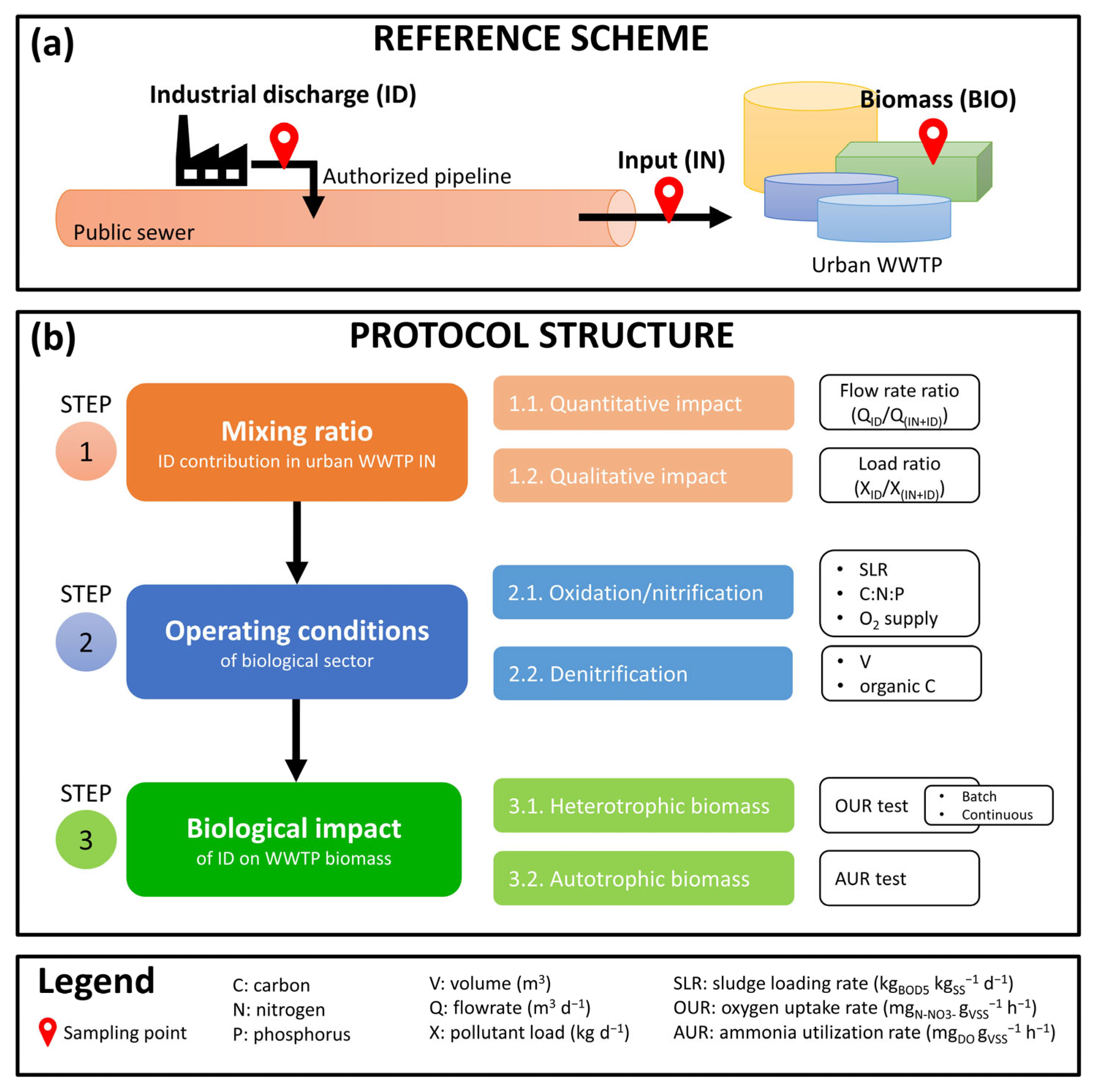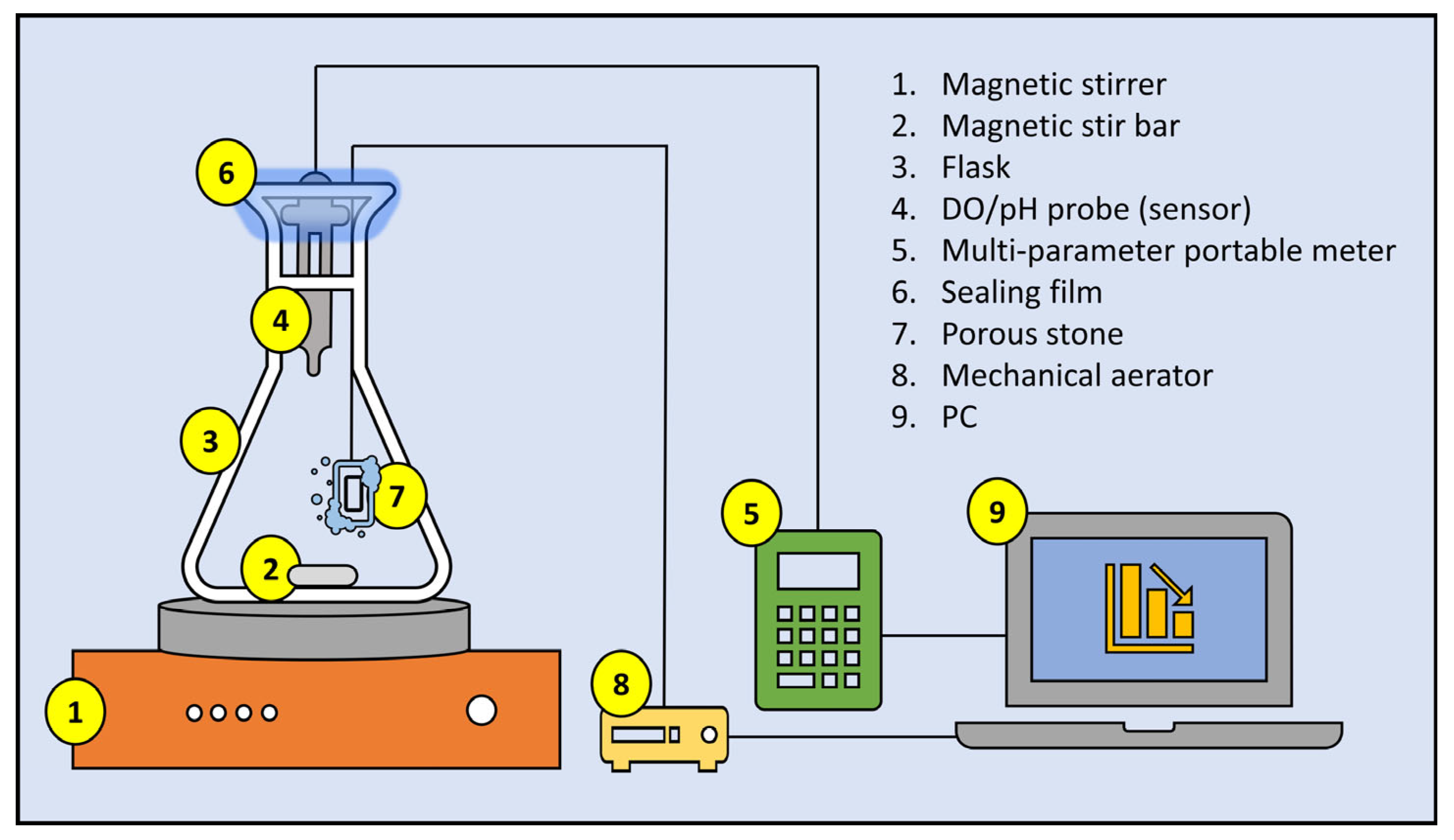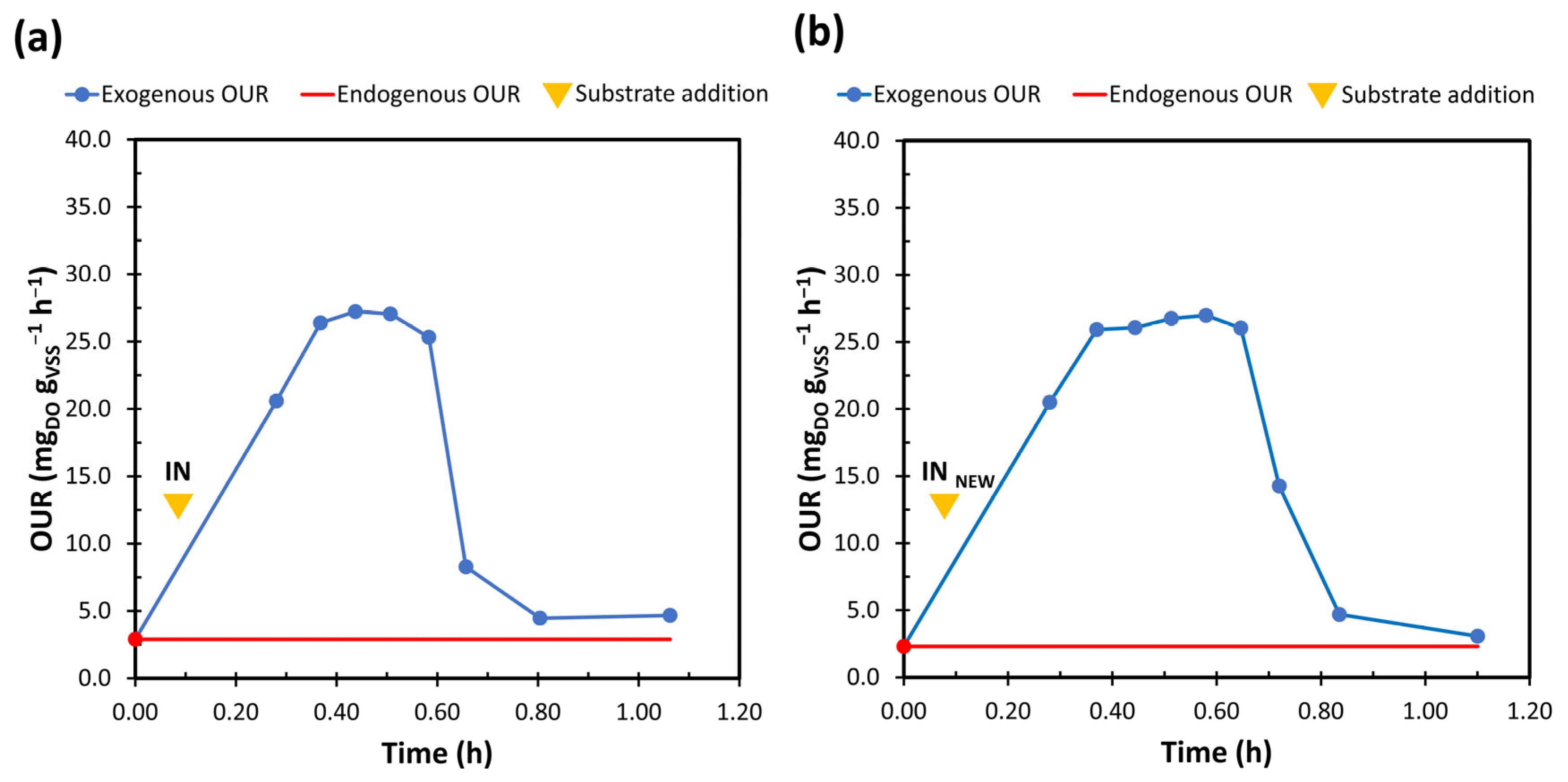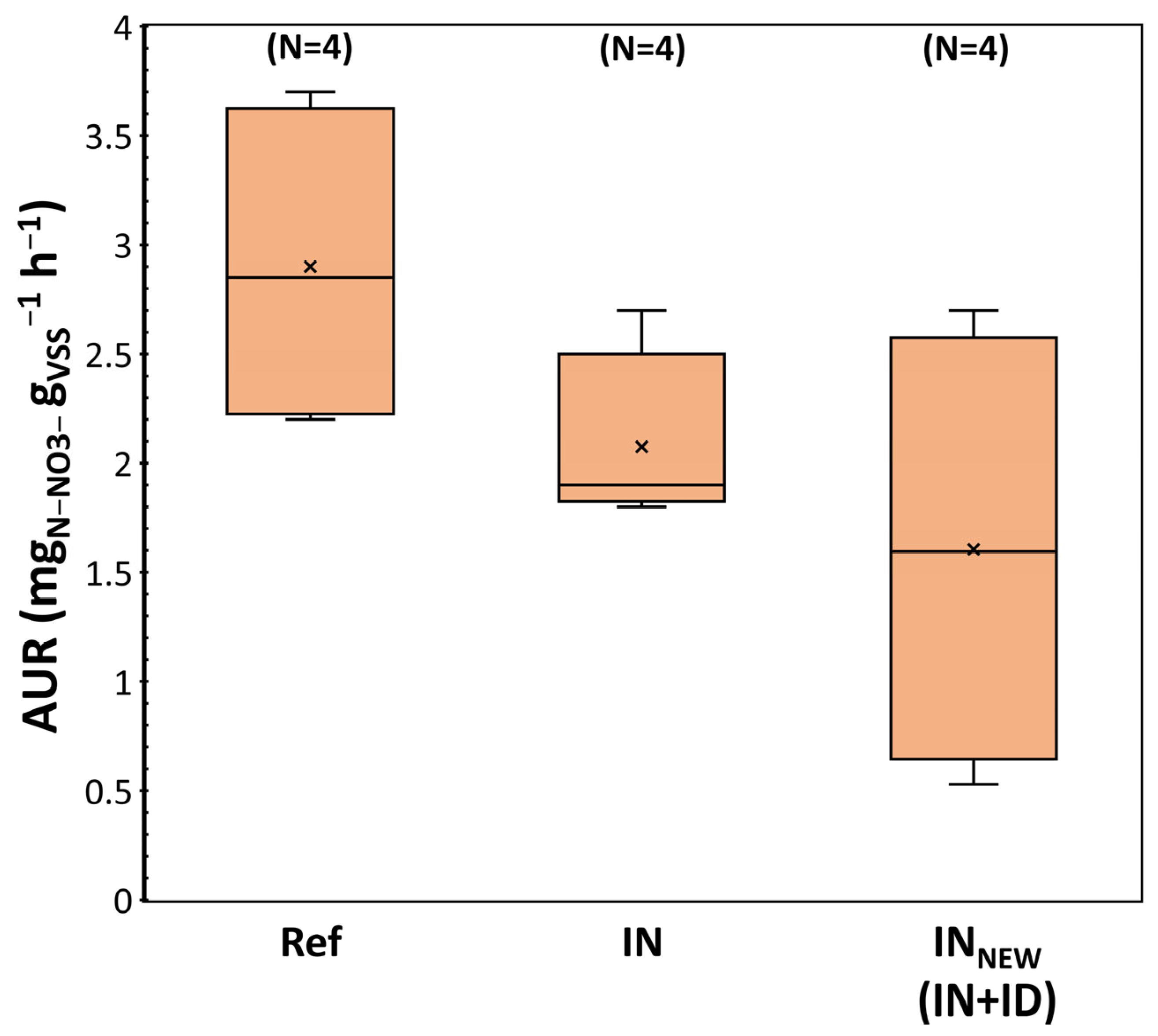Assessment of the Impact of a New Industrial Discharge on an Urban Wastewater Treatment Plant: Proposal for an Experimental Protocol
Abstract
1. Introduction
- (i)
- the proposal and development of a technical-scientific experimental methodology, shared and universally applicable by all water utilities, also to guarantee homogeneous and unambiguous comparisons between different realities;
- (ii)
- the promotion of greater integration and application of respirometry into WWTP management as a diagnostic tool, in particular for ecotoxicity assessments of new industrial sewerage connections.
2. Materials and Methods
2.1. Case Study and ID Characteristics
2.2. Experimental Protocol Structure
- (i)
- ID: industrial water which must be discharged into the public sewer.
- (ii)
- IN: WW entering the WWTP (without ID).
- (iii)
- BIO: biomass in the oxidation-nitrification tank.
- Step 1 concerns the estimation of the weight of the ID on the WW to be treated in the WWTP. We assessed (i) the quantitative impact of the ID on the WWTP through the ratio between the ID flowrate QID and the mixed WW flowrate Q(IN+ID) (or QINNEW), and (ii) the qualitative impact of the ID on the WWTP through the ratio between the mass load of selected pollutants in the ID (XID) and the mixed WW (X(IN+ID) or XINNEW). The pollutants of concern should be identified as the most significant and critical for the WWTP.
- Step 2 includes a check of the operating conditions in which the oxidation/nitrification and denitrification reactors should work with the addition of the new ID into the sewer. First, it is necessary to check the volumes available, in order to verify any possible under-sizing caused by the ID. Subsequently, for the oxidation/nitrification stage, the following checks should be carried out: (i) the new sludge loading rate (SLR) has to guarantee the correct performance of the nitrification process; (ii) the new BOD:N:P ratio should not deviate too much from the optimal one for aerobic systems equal to 100:5:1 (BOD/N = 20, BOD/P = 100) [16,17,18,19]; (iii) the capacity of the present air supply system has to cover the increase in the oxygen demand for the oxidation processes. For denitrification, the availability of organic carbon with respect to the new load of N-NO3− must be envisaged.
- Step 3 involves the study of the ID biological impact on the biomass grown in the urban WWTP and represents a crucial assessment. For a CAS system, the biological activities of heterotrophic and autotrophic biomass can be evaluated through oxygen uptake rate (OUR) and ammonia utilization rate (AUR) tests, respectively. In case potential criticalities arose from Step 1 and Step 2, a more in-depth analysis through the application of continuous respirometry is strictly recommended. In effect, thanks mainly to the longer duration of the test, it is possible to obtain more detailed information on the biological activity, compared to the more immediate and easier to apply batch OUR tests (described below in Section 2.5.2). Indeed, the authors advise to include continuous OUR tests, regardless of the result of point 1.
2.3. Mixing Ratio Estimate (Step 1)
- -
- QID (m3 d−1): estimated ID flow rate.
- -
- Q(ID+IN) (or QINNEW) (m3 d−1): sum of IN point flow rate, from WWTP monitoring data, and estimated ID flow rate. This represents the overall WW arriving from the sewer and treated by WWTP, if ID is authorised.
- -
- XID (kg d−1): load of generic ID polluting parameter.
- -
- X(ID+IN) (or XINNEW) (kg d−1): sum of IN pollutant load, from WWTP monitoring data, and ID pollutant load for the generic parameter. This represents the overall load of WW arriving from the sewer and treated by the WWTP, if ID is authorised.
2.4. Operating Conditions (Step 2)
- -
- XBOD5,IN BIO (kg d−1): BOD5 daily load entering the biological oxidation/nitrification compartment.
- -
- SS (kg m−3): total suspended solids concentration in the oxidation/nitrification tank (hp: equal in both IN and INNEW phases).
- -
- Vox (m3): volume of the existing oxidation/nitrification tank.
- -
- k (-): safety factor to consider for the oscillations of the influent load to the WWTP, assumed equal to 1.5.
- -
- α (kgO2 kgBOD5removed): amount of oxygen required to oxidize 1 kg of organic substance (BOD5) in the oxidation tank, assumed equal to 0.5 [20].
- -
- XBOD5,IN BIO (kg d−1): BOD5 average daily load entering the biological oxidation/nitrification compartment;
- -
- β (kgO2 kgSS−1 d−1): amount of oxygen consumed in 1 day by 1 kg of biomass, assumed equal to 0.1 [20].
- -
- Vox (m3): volume of the existing oxidation/nitrification tank.
- -
- SS (kg m−3): total suspended solids concentration in oxidation/nitrification tank (hp: equal in both IN and INNEW phases).
- -
- γ (kgO2 kgN): amount of oxygen required to nitrify 1 kg of ammonia nitrogen, assumed equal to 4.57 [20].
- -
- Xnit (kg d−1): nitrogen daily load which must be nitrified, determined by a balance on total Kjeldahl nitrogen (TKN) (Equation (5)):
- TKNIN (kg d−1): TKN of WW entering the WWTP (if possible, better entering the biological reactor).
- TKNass (kg d−1): TKN assimilated by the biomass for vital functions, calculated as 5% of BOD5 removed [21].
- TKNout (kg d−1): TKN limit load in the WWTP effluent and calculated from a concentration limit equal to 2 mg L−1, assumed based on the emission limits of the Italian regulation (Table 2, Annex 5, Part III, Legislative Decree n° 152 of 2006 [4]).
- -
- Xden (kg d−1): nitrogen daily load which must be denitrified, determined by a balance on TN (Equation (7)):
- TNIN (kg d−1): TN of WW entering the WWTP.
- TNass (kg d−1): TN assimilated by biomass for vital functions, calculated as 5% of BOD5 removed in the oxidation tank [19].
- TNout (kg d−1): TN limit load in the WWTP effluent and calculated from a concentration limit equal to 8 mg L−1, assumed based on the emission limits of the Italian regulation (Annex 5, Part III, Legislative Decree n° 152 of 2006 [4]).
- -
- -
- VSS (kg m−3): volatile suspended solids concentration in denitrification tank (hp: equal in both IN and INNEW phases).
- -
- BOD5/N-NO3− ratio (-) necessary to ensure efficient denitrification, assumed equal to 5 [20].
- -
- Xden (kg d−1): nitrogen daily load which must be denitrified, determined with Equation (7).
2.5. OUR and AUR Tests (Step 3)
2.5.1. Analytical Methods
2.5.2. OUR Test
Batch Test
Continuous Test
2.5.3. AUR Test
3. Results and Discussion
3.1. Step 1: Mixing Ratio
3.2. Step 2: Operating Conditions of the Biological Stage
3.3. Step 3: Biological Impact on Biomass
3.3.1. Heterotrophic Biomass
3.3.2. Autotrophic Biomass
4. Future Outlooks
5. Conclusions
Author Contributions
Funding
Data Availability Statement
Conflicts of Interest
Abbreviations
| AUR | Ammonia utilization rate |
| AWTP | Aqueous waste treatment plant |
| BIO | Oxidation/nitrification biomass |
| CAS | Conventional activated sludge |
| COD | Chemical oxygen demand |
| DO | Dissolved oxygen |
| ID | Industrial discharge |
| IN | Input to the WWTP |
| N-NH4+ | Ammoniacal nitrogen |
| N-NO3− | Nitric nitrogen |
| OC | Organic carbon |
| OUR | Oxygen uptake rate |
| TN | Total nitrogen |
| TKN | Total Kjeldahl nitrogen |
| SLR | Sludge loading rate |
| SS | Total suspended solids |
| VSS | Volatile suspended solids |
| WW | Wastewater |
| WWTP | Wastewater treatment plant |
References
- Ren, S. Assessing wastewater toxicity to activated sludge: Recent research and developments. Environ. Int. 2004, 30, 1151–1164. [Google Scholar] [CrossRef]
- Hagman, M.; La, J.; Jansen, C. Oxygen uptake rate measurements for application at wastewater treatment plants. Vatten 2007, 63, 131–138. [Google Scholar]
- Mhlanga, F.T.; Brouckaert, C.J. Characterisation of wastewater for modelling of wastewater treatment plants receiving industrial effluent. Water SA 2012, 39, 403–408. [Google Scholar] [CrossRef]
- Government of Italy Legislative Decree 3 April 2006, n. 152. Environmental Regulations. Available online: https://www.gazzettaufficiale.it/dettaglio/codici/materiaAmbientale (accessed on 17 January 2023). (In Italian)
- Rahman, M.S.; Mousumi, M.Z.; Sakib, M.A.A.; Chy, T.J.; Fahad, M.S.A.; Author, C. Development of a respirometry and cod based rapid experimental protocol for analyzing wastewater. In Proceedings of the 4th International Conference on Advances in Civil Engineering 2018 (ICACE 2018), CUET, Chittagong, Bangladesh, 19–21 December 2018; pp. 19–21. [Google Scholar]
- Li, Z.H.; Zhu, Y.M.; Yang, C.J.; Zhang, T.Y.; Yu, H.Q. A simple respirogram-based approach for the management of effluent from an activated sludge system. Bioresour. Technol. 2018, 261, 412–419. [Google Scholar] [CrossRef] [PubMed]
- Torretta, V.; Ragazzi, M.; Trulli, E.; De Feo, G.; Urbini, G.; Raboni, M.; Rada, E.C. Assessment of biological kinetics in a conventional municipal WWTP by means of the oxygen uptake rate method. Sustainability 2014, 6, 1833–1847. [Google Scholar] [CrossRef]
- Collivignarelli, M.C.; Bertanza, G.; Abbà, A.; Torretta, V.; Katsoyiannis, I.A. Wastewater treatment by means of thermophilic aerobic membrane reactors: Respirometric tests and numerical models for the determination of stoichiometric/kinetic parameters. Environ. Technol. 2019, 40, 182–191. [Google Scholar] [CrossRef]
- Arias-Navarro, M.; Villen-Guzman, M.; Perez-Recuerda, R.; Rodriguez-Maroto, J.M. The use of respirometry as a tool for the diagnosis of waste water treatment plants. A real case study in Southern Spain. J. Water Process Eng. 2019, 29, 100791. [Google Scholar] [CrossRef]
- Vasiliadou, I.A.; Molina, R.; Martinez, F.; Melero, J.A.; Stathopoulou, P.M.; Tsiamis, G. Science of the Total Environment Toxicity assessment of pharmaceutical compounds on mixed culture from activated sludge using respirometric technique: The role of microbial community structure. Sci. Total Environ. 2018, 630, 809–819. [Google Scholar] [CrossRef]
- Oviedo, M.D.C.; Sánchez, J.B.; Cruz, C.A.; Alonso, J.M.Q. A new approach to toxicity determination by respirometry. Environ. Technol. 2009, 30, 1601–1605. [Google Scholar] [CrossRef]
- Aguilar, M.I.; Lloréns, M.; Fernández-Garrido, J.M.; Pérez-Marín, A.B.; Ortuño, J.F.; Meseguer, V.F. Heavy metals effect on the heterotrophic activity of activated sludge. Int. J. Environ. Sci. Technol. 2020, 17, 3111–3118. [Google Scholar] [CrossRef]
- Borzooei, S.; Simonetti, M.; Scibilia, G.; Chiara, M. Journal of Environmental Chemical Engineering Critical evaluation of respirometric and physicochemical methods for characterization of municipal wastewater during wet-weather events. J. Environ. Chem. Eng. 2021, 9, 105238. [Google Scholar] [CrossRef]
- Vitanza, R.; Colussi, I.; Cortesi, A.; Gallo, V. Implementing a respirometry-based model into BioWin software to simulate wastewater treatment plant operations. J. Water Process Eng. 2016, 9, 267–275. [Google Scholar] [CrossRef]
- Mainardis, M.; Buttazzoni, M.; Cottes, M.; Moretti, A.; Goi, D. Science of the Total Environment Respirometry tests in wastewater treatment: Why and how? A critical review. Sci. Total Environ. 2021, 793, 148607. [Google Scholar] [CrossRef]
- Bashaar, Y.A. Nutrients requirements in biological industrial wastewater treatment. Afr. J. Biotechnol. 2004, 3, 236–238. [Google Scholar] [CrossRef]
- Permatasari, R.; Rinanti, A.; Ratnaningsih, R. Treating domestic effluent wastewater treatment by aerobic biofilter with bioballs medium. IOP Conf. Ser. Earth Environ. Sci. 2018, 106, 012048. [Google Scholar] [CrossRef]
- Hamza, R.A.; Zaghloul, M.S.; Iorhemen, O.T.; Sheng, Z.; Tay, J.H. Optimization of organics to nutrients (COD:N:P) ratio for aerobic granular sludge treating high-strength organic wastewater. Sci. Total Environ. 2019, 650, 3168–3179. [Google Scholar] [CrossRef]
- Metcalf & Eddy Inc.; Tchobanoglous, G.; David Stensel, H.; Tsuchihashi, R.; Burton, F.L. Wastewater Engineering: Treatment and Resource Recovery, 5th ed.; McGraw-Hill: London, UK, 2013; ISBN 9780073401188. [Google Scholar]
- Masotti, L. Depurazione delle Acque. Tecniche ed Impianti per il Trattamento delle Acque di Rifiuto; Calderini: Milan, Italy, 2011. (In Italian) [Google Scholar]
- Metcalf & Eddy Inc.; Tchobanoglous, G.; Burton, F.L.; Stensel, H.D. Wastewater Engineering: Treatment and Reuse, 4th ed.; McGraw-Hill: New York, NY, USA, 2003. [Google Scholar]
- Raboni, M.; Torretta, V.; Viotti, P.; Urbini, G. Calculating specific denitrification rates in pre-denitrification by assessing the influence of dissolved oxygen, sludge loading and mixed-liquor recycle. Environ. Technol. 2014, 35, 2582–2588. [Google Scholar] [CrossRef]
- Raboni, M.; Viotti, P.; Rada, E.C.; Conti, F.; Boni, M.R. The sensitivity of a specific denitrification rate under the dissolved oxygen pressure. Int. J. Environ. Res. Public Health 2020, 17, 9366. [Google Scholar] [CrossRef]
- US EPA Process Design Manual for Nitrogen Control. Available online: https://nepis.epa.gov/Exe/ZyNET.exe/9100PUPQ.TXT?ZyActionD=ZyDocument&Client=EPA&Index=Prior+to+1976&Docs=&Query=&Time=&EndTime=&SearchMethod=1&TocRestrict=n&Toc=&TocEntry=&QField=&QFieldYear=&QFieldMonth=&QFieldDay=&IntQFieldOp=0&ExtQFieldOp=0&XmlQuery=& (accessed on 10 March 2023).
- Collivignarelli, M.C.; Abbà, A.; Caccamo, F.M.; Miino, M.C.; Durante, A.; Bellazzi, S.; Baldi, M.; Bertanza, G. How to Produce an Alternative Carbon Source for Denitrification by Treating and Drastically Reducing Biological Sewage Sludge. Membranes 2021, 11, 977. [Google Scholar] [CrossRef]
- Collivignarelli, M.C.; Carnevale Miino, M.; Caccamo, F.M.; Baldi, M.; Abbà, A. Performance of full-scale thermophilic membrane bioreactor and assessment of the effect of the aqueous residue on mesophilic biological activity. Water 2021, 13, 1754. [Google Scholar] [CrossRef]
- Kristensen, G.H.; Jorgensen, P.E.; Henze, M. Characterization of functional microorganism groups and substrate in activated sludge and wastewater by AUR, NUR and OUR. Water Sci. Technol. 1992, 25, 43–57. [Google Scholar] [CrossRef]
- Collivignarelli, M.C.; Pedrazzani, R.; Bellazzi, S.; Carnevale Miino, M.; Caccamo, F.M.; Baldi, M.; Abbà, A.; Bertanza, G. Numerical Analysis of a Full-Scale Thermophilic Biological System and Investigation of Nitrate and Ammonia Fates. Appl. Sci. 2022, 12, 6952. [Google Scholar] [CrossRef]
- Surmacz-Gorska, J.; Gernaey, K.; Demuynck, C.; Vanrolleghem, P.; Verstraete, W. Nitrification monitoring in activated sludge by oxygen uptake rate (OUR) measurements. Water Res. 1996, 30, 1228–1236. [Google Scholar] [CrossRef]
- ISPRA Measurement Procedure for the Determination of the Chemical Oxygen Demand (COD) by Cuvette Test: Method 5135. Available online: https://www.isprambiente.gov.it/it/pubblicazioni/manuali-e-linee-guida/procedura-di-misurazione-per-la-determinazione-della-richiesta-chimica-di-ossigeno-cod-mediante-test-in-cuvetta-metodo-5135 (accessed on 25 May 2023). (In Italian)
- APAT-IRSA-CNR 4030 Analytical Methods for Water. Section 4000—Non-Metallic Inorganics. Ammonia Nitrogen. Non-Metallic Inorganic Constituents. METHOD A1—Spectrophotometric Determination of Indophenol. Available online: https://www.irsa.cnr.it/wp/wp-content/uploads/2022/04/Vol2_Sez_4000_InorganiciNonMetallici.pdf (accessed on 12 May 2023). (In Italian).
- APAT-IRSA-CNR 5030 Analytical Methods for Water. Section 5000—Organic Constituents. Organic Nitrogen. Available online: https://www.irsa.cnr.it/wp/wp-content/uploads/2022/04/Vol2_Sez_5000_Organici.pdf (accessed on 25 May 2023). (In Italian).
- UNI EN ISO 10304-1:2009 Water Quality—Determination of Dissolved Anions by Ion Liquid Chromatography—Part 1: Determination of Bromides, Chlorides, Fluorides, Nitrates, Nitrites, Phosphates and Sulphates. Available online: https://store.uni.com/uni-en-iso-10304-1-2009 (accessed on 25 May 2023). (In Italian).
- UNI 11658:2016 Water Quality—Determination of Total Nitrogen in Wastewater, Natural and Intended for Human Consumption by Means of a Cuvette Test. Available online: https://store.uni.com/uni-11658-2016 (accessed on 25 May 2023). (In Italian).
- APAT-IRSA-CNR 2090 Analytical Methods for Water. Section 2000—Physical, Chemical Parameters and Chemical-Physical. Solids (Total Dissolved; Total Suspended; Sedimentable; Fixed and Volatile at 600 °C). Available online: https://www.irsa.cnr.it/wp/wp-content/uploads/2022/04/Vol1_Sez_2000_Parametri-chimico-fisici.pdf (accessed on 12 May 2023). (In Italian).
- Rahman, M.S.; Islam, M.A.; Habib, S.; Sarker, J. Measuring Biodegradability of Industrial Wastewater by A Low-Cost Differential Respirometer. Res. J. Eng. Sci. 2013, 2, 1–4. [Google Scholar]
- Hoque, M.A.; Aravinthan, V.; Pradhan, N.M. Can we decode the messages of activated sludge through the respirograms? Water Air Soil Pollut. Focus 2009, 9, 449–459. [Google Scholar] [CrossRef]
- Andreottola, G.; Foladori, P.; Ziglio, G.; Cantaloni, C.; Bruni, L.; Cadonna, M. Methods for Toxicity Testing of Xenobiotics in Wastewater Treatment Plants and in Receiving Water Bodies. In Dangerous Pollutants (Xenobiotics) in Urban Water Cycle; Springer: Dordrecht, The Netherlands, 2007; pp. 191–206. [Google Scholar]
- Capodici, M.; Fabio, S.; Di, F.; Di, D.; Torregrossa, M. An innovative respirometric method to assess the autotrophic active fraction: Application to an alternate oxic–anoxic MBR pilot plant. Chem. Eng. J. 2016, 300, 367–375. [Google Scholar] [CrossRef]
- Etienne, P.; Mathieu, S. Estimation of wastewater biodegradable COD fractions by combining respirometric experiments in various So/Xo ratios. Water Res. 2000, 34, 1233–1246. [Google Scholar]
- Di Trapani, D.; Christensson, M.; Torregrossa, M.; Viviani, G.; Ødegaard, H. Performance of a hybrid activated sludge/biofilm process for wastewater treatment in a cold climate region: Influence of operating conditions. Biochem. Eng. J. 2013, 77, 214–219. [Google Scholar] [CrossRef]
- Statiris, E.; Dimopoulos, T.; Petalas, N.; Noutsopoulos, C.; Mamais, D.; Malamis, S. Investigating the long and short-term effect of free ammonia and free nitrous acid levels on nitritation biomass of a sequencing batch reactor treating thermally pre-treated sludge reject water. Bioresour. Technol. 2022, 362, 127760. [Google Scholar] [CrossRef]
- Inglezakis, V.J.; Malamis, S.; Omirkhan, A.; Nauruzbayeva, J.; Makhtayeva, Z.; Seidakhmetov, T.; Kudarova, A. Investigating the inhibitory effect of cyanide, phenol and 4-nitrophenol on the activated sludge process employed for the treatment of petroleum wastewater. J. Environ. Manag. 2017, 203, 825–830. [Google Scholar] [CrossRef]
- Kujawa, K.; Klapwijk, B. A method to estimate denitrification potential for predenitrification systems using NUR batch test. Water Res. 1999, 33, 2291–2300. [Google Scholar] [CrossRef]
- Peng, Y.Z.; Ma, Y.; Wang, S. ying Denitrification potential enhancement by addition of external carbon sources in a pre-denitrification process. J. Environ. Sci. 2007, 19, 284–289. [Google Scholar] [CrossRef]
- Itokawa, H.; Hanaki, K.; Matsuo, T. Nitrous oxide production in high-loading biological nitrogen removal process under low cod/n ratio condition. Water Res. 2001, 35, 657–664. [Google Scholar] [CrossRef]
- Collivignarelli, M.C.; Abbà, A.; Bertanza, G.; Baldi, M.; Setti, M.; Frattarola, A.; Carnevale Miino, M. Treatment of high strength wastewater by thermophilic aerobic membrane reactor and possible valorisation of nutrients and organic carbon in its residues. J. Clean. Prod. 2021, 280, 124404. [Google Scholar] [CrossRef]
- Collivignarelli, M.C.; Carnevale Miino, M.; Arab, H.; Bestetti, M.; Franz, S. Efficiency and Energy Demand in Polishing Treatment of Wastewater Treatment Plants Effluents: Photoelectrocatalysis vs. Photocatalysis and Photolysis. Water 2021, 13, 821. [Google Scholar] [CrossRef]
- Dulekgurgen, E.; Doǧruel, S.; Karahan, Ö.; Orhon, D. Size distribution of wastewater COD fractions as an index for biodegradability. Water Res. 2006, 40, 273–282. [Google Scholar] [CrossRef]
- Lagarde, F.; Tusseau-Vuillemin, M.H.; Lessard, P.; Héduit, A.; Dutrop, F.; Mouchel, J.M. Variability estimation of urban wastewater biodegradable fractions by respirometry. Water Res. 2005, 39, 4768–4778. [Google Scholar] [CrossRef]





| Mean Value | Confidence Interval | |
|---|---|---|
| pH (-) | 10.1 [n: 12] | ±0.24 |
| COD (mg L−1) | 2143 [n: 12] | ±85 |
| BOD5 (mg L−1) | 317 [n: 12] | ±77 |
| TN (mg L−1) | 154 [n: 5] | ±50 |
| N-NO3− (mg L−1) | 15.5 [n: 12] | ±3.5 |
| N-NH4+ (mg L−1) | 15.4 [n: 12] | ±3.5 |
| ID | IN | INNEW * (IN + ID) | Mixing Ratio (ID/INNEW) | |
|---|---|---|---|---|
| Q (m3 d−1) | 200 ± 50 | 45.575 ± 2053 | 45.775 | 0.45 ± 0.05% |
| [set/estimated] | [n: 12] | [calculated] | [n: 12] | |
| COD (kg d−1) | 441 ± 43 | 12.677 ± 2606 | 13.118 | 3.7 ± 0.7% |
| [n: 12] | [n: 70] | [calculated] | [n: 12] | |
| TN (kg d−1) | 28.4 ± 9.3 | 1044.6 ± 10 | 1073 | 2.6 ± 0.9% |
| [n: 5] | [n: 5] | [calculated] | [n: 5] | |
| N-NO3− (kg d−1) | 3.0 ± 0.8 | 10.1 ± 3.4 | 13 | 27.3 ± 8.5% |
| [n: 12] | [n: 70] | [calculated] | [n: 12] | |
| N-NH4+ (kg d−1) | 3.2 ± 0.9 | 731.1 ± 94 | 734 | 0.44 ± 0.12% |
| [n: 12] | [n: 70] | [calculated] | [n: 12] |
| IN | INNEW (IN + ID) | |
|---|---|---|
| Oxidation/nitrification | ||
| SLR (kgBOD5 kgSS−1 d−1) | 0.111 | 0.109 |
| BOD:N:P | 100:26:4 | 100:26:4 |
| Oxygen supply (kgO2 d−1) | 12′300 | 12′400 |
| Denitrification | ||
| VDEN (m3) | 6700 (14 °C) 3785 (20 °C) (Real volume: 6000 m3) | 6990 (14 °C) 3950 (20 °C) (Real volume: 6000 m3) |
| OC (kg d−1) | 2500 (BOD5, IN BIO: 4370 kg d−1) | 2600 (BOD5, IN BIO: 4440 kg d−1) |
Disclaimer/Publisher’s Note: The statements, opinions and data contained in all publications are solely those of the individual author(s) and contributor(s) and not of MDPI and/or the editor(s). MDPI and/or the editor(s) disclaim responsibility for any injury to people or property resulting from any ideas, methods, instructions or products referred to in the content. |
© 2023 by the authors. Licensee MDPI, Basel, Switzerland. This article is an open access article distributed under the terms and conditions of the Creative Commons Attribution (CC BY) license (https://creativecommons.org/licenses/by/4.0/).
Share and Cite
Collivignarelli, M.C.; Caccamo, F.M.; Bellazzi, S.; Abbà, A.; Bertanza, G. Assessment of the Impact of a New Industrial Discharge on an Urban Wastewater Treatment Plant: Proposal for an Experimental Protocol. Environments 2023, 10, 108. https://doi.org/10.3390/environments10070108
Collivignarelli MC, Caccamo FM, Bellazzi S, Abbà A, Bertanza G. Assessment of the Impact of a New Industrial Discharge on an Urban Wastewater Treatment Plant: Proposal for an Experimental Protocol. Environments. 2023; 10(7):108. https://doi.org/10.3390/environments10070108
Chicago/Turabian StyleCollivignarelli, Maria Cristina, Francesca Maria Caccamo, Stefano Bellazzi, Alessandro Abbà, and Giorgio Bertanza. 2023. "Assessment of the Impact of a New Industrial Discharge on an Urban Wastewater Treatment Plant: Proposal for an Experimental Protocol" Environments 10, no. 7: 108. https://doi.org/10.3390/environments10070108
APA StyleCollivignarelli, M. C., Caccamo, F. M., Bellazzi, S., Abbà, A., & Bertanza, G. (2023). Assessment of the Impact of a New Industrial Discharge on an Urban Wastewater Treatment Plant: Proposal for an Experimental Protocol. Environments, 10(7), 108. https://doi.org/10.3390/environments10070108












